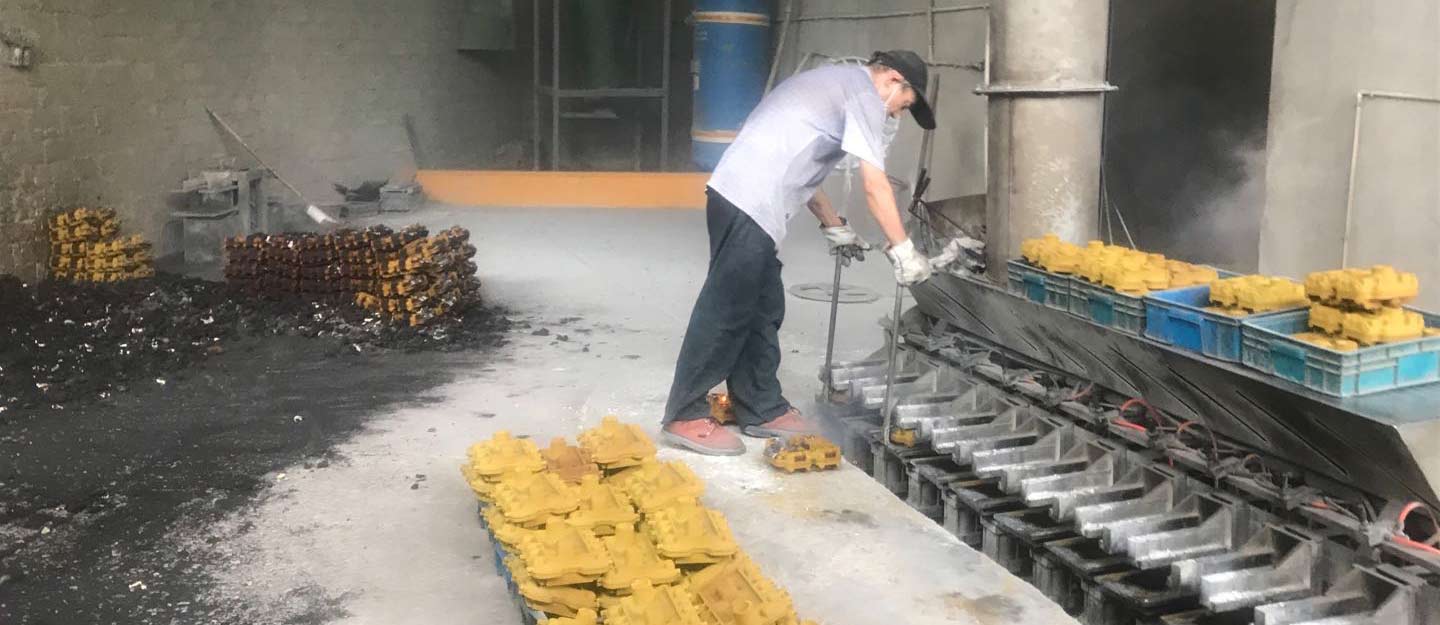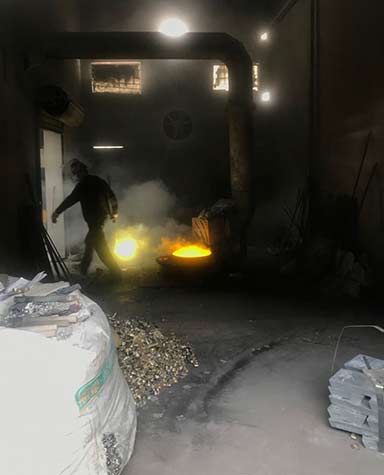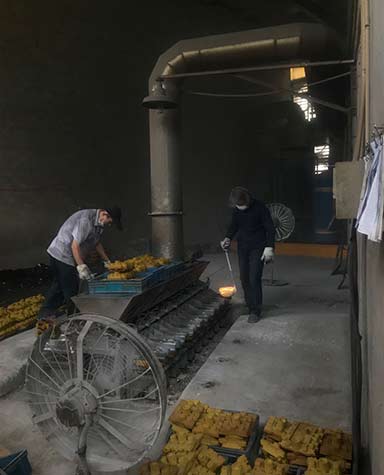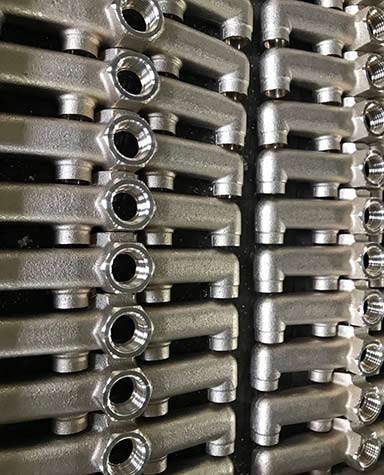Shell Molding Iron Castings
Shell molding casting process is also called as pre-coated resin sand casting process, hot shell and core casting process.
The main molding material is the pre-coated phenolic resin sand, which is more expensive than green sand and furan resin sand. Moreover, this sand can not be recycle used. So, the shell molding iron castings are more costly.
The advantages of shell molding castings are high dimensional tolerance, good surface quality, and less casting defects.
Shell Molding Casting Production Process

casting brass cast pouring into pre-coated resin sand castle cast

brass casting process

brass casting pouring into shell sand castle cast

pipe brass casting with shell sand casting
Yide casting manufactures brass casting, iron ductile casting and grey iron casting, applied in cast iron teapot, iron cast check valve, ductile iron pipe flare castings, manhole cover, stove burner, cast iron plate, butterfly valve casting, cradle bracket of cylinder etc.
Yide casting (JM factory) pour these liquid melton iron into the sand castle, then this melton iron will form as a roughcasting product after cooling. Finally, JM factory will machine the roughcasting parts, so that these casting products can be used as the machinery parts, like a truck, forklift, or tractor.
FAQ GUIDE OF SHEEL MODLE CASTING
Benefits of Shell Mold Casting
There are several benefits of shell mold casting. For example, it is less expensive than traditional metal pattern casting. The cast piece will have a smoother finish. It uses a thermosetting resin binder, so the casting process will produce a lower-cost, high-quality finished product. Another advantage of shell mold casting is its versatility. While the shell mold does require more metal than other types of casting processes, it is a good choice for a wide variety of projects.
Cost of metal pattern
Metal patterns are necessary to create expendable shell molds. Generally, a metal pattern has two parts. A steel or iron pattern is more durable and will give your finished shell mold more utility. However, aluminum patterns can save you money in the long run. The metal casting process uses a mixture of resin, sand, lubricants, backing material, and a furnace. A heavy flask is used to hold the shell mold during the casting process. Metal casting is done in low-tech environments or high-tech automated facilities.
A metal pattern for shell mold casting can be expensive, but if you’re planning to invest in the process, it’s worth every penny. You’ll find that metal patterns can be as inexpensive as $20. The best solution to this problem is to partner with a foundry that takes product design seriously. The experienced staff at Dandong Foundry can answer any questions you have about the cost of metal patterns.
Smoother cast finish
The process of shell mold casting involves a sand-based, thin-walled mold. The mold is created by applying a mixture of sand and thermosetting resin to a metal pattern, which is the shape of the part to be cast. Multiple shell molds are produced using this process. Metal patterns are typically made of steel, iron, or graphite, but they can also be made of aluminum or graphite.
The process begins with the pattern being lubricated and heated. Next, the pattern is clamped onto a dump box, which contains a mixture of sand and thermosetting phenolic resin binder. The pattern is then partially cured with the mixture, and the shell forms around it. The process is repeated to make cores and then the shell is removed. The shell is then removed from the pattern, the cores are placed inside, and molten metal is poured into the gating system.
Cost of thermosetting resin binder
Thermoset plastic resin is used in the making of shell moulds. Its cost is dependent on the type of mould and the tensile strength required. Its cost ranges from $2 per gram to more than $100 per pound. This type of resin is used in both metal casting and plastic injection molding. The tensile strength is measured in psi, which is equivalent to two to three MPa.
The shell moulding method uses a relatively small percentage of sand to produce a dense, high-quality shell. However, it requires a substantial amount of thermosetting resin binder, which significantly increases the cost of the process. Also, shell molds require special metal patterns. This makes them less desirable for small or medium-sized runs, but may be affordable in larger batch productions. The cost of thermosetting resin binder for shell mold casting is high, but shell molds are easy to automate and require less maintenance.
Versatility
When it comes to the design and manufacture of metal parts, shell mold casting is highly versatile. The design and construction of a shell mold require the use of two separate patterns. The top half and the bottom half are known as the cope and drag, respectively. The two halves are then merged to form a complete shell mold. After the two halves are merged, the metal is poured into the gating system. The molten metal solidifies and forms the part.
The process of shell mold casting involves assembling a pattern made of metal with a design that is capable of enduring high temperatures and the abrasion caused by sand. Then, a mixture of sand and resin is applied to the pattern and cured in a moulding oven. When it is ready, the pattern is removed, and the other half of the shell is created. This technique offers incredible versatility for metal casting.
Cost of ejector pins
Ejector pins are used to eject plastic parts from a mold. The pins can be made of stainless steel, but these materials tend to gall quickly. Most molders use copper alloy core pins instead, which resist galling and are significantly cheaper. If you’re considering purchasing ejector pins for your next molding job, make sure you consider the costs of replacing them. In addition, consider replacing your old pins if they’re showing signs of wear.
While stainless steel pins are expensive, they’re also highly durable, with oxidation resistance up to 600degC. Stainless steel pins are also resistant to virtually any operating environment. Stainless steel ejector pins are typically used in high-end medical applications. They offer significant cost-cutting advantages over their steel counterparts and are compatible with many tooling types. Depending on your needs, you can stock one material over another.
Shell Molding Vs Investment Casting
When considering the advantages and disadvantages of shell molding vs investment casting, the answer lies in size. While there are many advantages to investment casting, the process has a lower maximum size than other shaped technologies. Because of this, it is a good choice for applications that need thin walls. The main challenge is that very small internal shapes present a number of challenges, such as holes that are no deeper than 1/16″ or a diameter of 1.5 times the diameter. This multi-step process takes longer than other alternatives, but the overall processing time is much shorter than other methods.
Greensand casting is a sand-based casting method
The advantages of greensand casting over other types of sand-based casting methods are largely cost reductions and flexibility. This process is suitable for low-to-medium-volume production runs, prototype castings, and the conversion of welded components to castings. It involves the use of moist sand, which is usually silica sand. The moisture is obtained from the clay that bonds the sand. The sand is uncured when molten metal is poured into it.
To begin with, greensand is not the same as greensand, which is a form of sandstone with a greenish color. This sand is a waste product of greensand-based shell molding. In greensand casting, a pattern is first carved out of a sand mixture, which then becomes a mold. Mold cavities are left behind after the pattern has been removed. The metal is then poured into the mould cavity through the sprue. This process is repeated for as many shell molds as needed, based on the ratio of sand to metal.
Permanent mold casting is a sand-based casting method
The permanent mold casting process is similar to sand casting, but it makes use of metal molds. In this process, molten metal is inserted into the mold using gravity. This produces a superior surface finish and dimensional accuracy. Another benefit of permanent mold casting is that it creates less waste than sand casting, which creates too much sand as a byproduct. Consequently, permanent mold casting is more cost-effective in large production runs, but it produces less quality parts if used in small batches.
This process uses sand that is mainly silica-based. It can be synthetic or naturally-bonded. The sand used is typically finely ground spherical particles that are tightly packed onto a smooth molding surface. This method minimizes flaws and allows moderate shrinkage during the cooling process. Sand-based molds can also be reinforced with clay to strengthen the bond between the particles.
Costs of permanent mold casting
One of the main costs of permanent mold casting is the cost of creating the mold. Permanent molds can be reused after each casting, requiring less energy than sand casting. They can also be reused multiple times, and they retain heat from previous castings. Other processes, such as airset casting or greensand casting, require additional processes and small amounts of heat. These extra costs can add up to significant cost savings for businesses.
The proper process for a permanent mold depends on the mechanical properties and volume requirements of the cast parts. Generally, the more complicated the process, the higher the tooling costs will be. One of the most basic types of permanent mold casting is gravity pouring, in which two metal mold halves are joined together to form a cavity. While gravity pouring is the most traditional form of permanent mold casting, it is not the only type.
Cost of shell mold casting
When comparing the cost of shell mold casting vs investment cast iron parts, there are a few factors that should be considered. Investment casting is time consuming and requires multiple processes to complete. Moreover, it often takes seven days from wax pattern to completed casting. Nevertheless, some foundries offer quick drying capabilities. Furthermore, investment casting requires more lead time than shell mold casting because of its time-consuming processes. In addition, most foundries are equipped with limited production facilities and limited equipment. Therefore, there are longer lead times for investment casting projects.
A shell mold cast part has a better surface finish and reproduces fine detail. Its process requires a minimum of draft angles. While sand casting requires two to three degrees of draft angles, shell molding can get away with as little as one degree. Additionally, it is easier to machine parts in shell mold casting because of the smaller draft angle. It also saves machining time as there are fewer steps in the finishing process.
Benefits of shell mold casting
Unlike traditional investment casting methods, shell mold casting produces precise parts without wax patterns. The shell mold process is a good alternative to investment casting when a specific part design is needed. The mold uses a cavity rather than wax to create the part pattern. The shell mold process also produces high-quality parts in a shorter amount of time. In addition to its high-quality casting, shell mold casting also saves a significant amount of time compared to other casting methods.
Both processes can be used to manufacture various components. The main difference between shell mold casting and investment casting is the cost of the casting process. Shell mold casting is more expensive than investment casting because it requires specialized labor and high-quality equipment. However, shell mold casting is much more efficient than investment casting, as it produces less waste. Also, unlike shell mold casting, shell molding does not require sand or resin for mold construction, which saves time.
Shell Molding Vs Sand Casting
Shell molding is a process in which a mold is made using sand and resin. The resin acts as a binder for the sand, which is poured into a mold that is heated to 400-700 degrees Fahrenheit. The heat causes a reaction between the resin and the sand, and the resulting product is a shell. This process requires less labor, and is better suited for smaller parts.
Shell molding uses sand mixed with a bonding resin to create a mold
This process is a precision sand casting method that produces parts with better dimensional accuracy and surface finish than investment casting and die-casting methods. It has the added benefit of greater design flexibility and lower cost. It was developed by Croning, a German company, during World War II and is also known as the Croning shell process. Here, sand is mixed with a bonding resin and applied to a metal pattern tool.
In shell molding, the sand is combined with a bonding resin and heated to a temperature of 400 to 700 degrees Fahrenheit. The sand grains then bond to the pattern, creating a mold that is ready to receive molten metal. Once the shell is complete, it can be reused immediately or stored for future use. This process can also be done in automated facilities.
It supports both ferrous and non-ferrous metals
Non-ferrous metals are the ones that are not found in ferrous alloys. These include aluminum, copper, nickel, tin, zinc, and precious metals. They are lighter and more malleable than ferrous alloys, making them excellent materials for electrical wiring and small electronics. However, these alloys are not suitable for all applications. You may want to consider switching to a non-ferrous alloy for your next project.
The use of non-ferrous metals in foundry processes makes them more expensive. Many non-ferrous metals are selected for their unique properties, such as being lighter than steel, more corrosion-resistant, or decorative. Before widespread manufacturing, these metals were considered luxury metals. Traditional sand casting foundries are also used for specialized castings. The processes and materials used in foundries vary in quality and pollution.
It is more expensive than sand casting
Shell molding is a process used to create a casting. This process uses a phenolic resin sand. It is more expensive than green or furan sand. The advantage of shell molding is that the mold is reusable. In contrast, sand casting uses cheaper materials. Both processes have their advantages. The main difference between sand and shell molding is that the former offers greater dimensional tolerance, while the latter offers poorer strength. Shell molding is more expensive than sand casting, but it is suitable for a wide variety of applications, including pressure vessels, weight-sensitive, and complex shapes.
Sand casting involves several steps. The sand is compacted to form a mold. The sand is then poured into a mold cavity, where the core boxes and copes are installed. Once the metal has solidified, the mold is cleaned. It is more expensive than shell molding, but it offers a better surface finish and thinner walls. Shell molding is best for small and middle-sized castings.
It requires green sand
Unlike other sand casting processes, shell molding requires a special type of sand. The silica sand used for shell molding is comparatively finer than the material used for sand casting. The American Foundry Society uses a fineness scale for the sand, with higher numbers indicating smaller grains. Green sand is typically between sixty and eighty on the fineness scale, while shell molding sand is one hundred percent fine or higher. When the mold is completed, it is coated with phenolic resin, which melts and forms the shell.
The sand used in green sand casting processes is made of a combination of lake or bank sand and various additives like clay, pitch, and cellulose. These materials are combined with the sand to form a mixture that resembles a plaster. Once this mixture is mixed, a mold board is mounted on top of the sand, and a suitable fask is placed around the pattern to form the mold.
